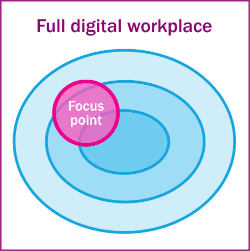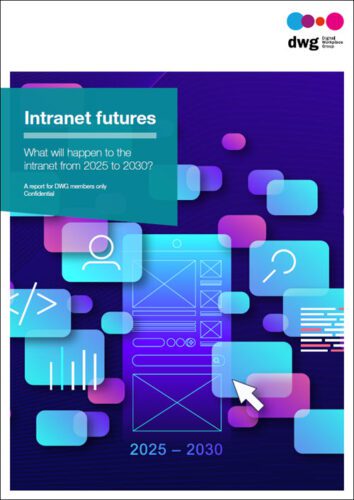With the digital workplace, focus is everything
Synopsis: Trying to overhaul your entire digital workplace simply won’t work. Instead, examine these four ways to narrow the scope of your digital workplace improvements.
Success with enterprise mobile: how tools for frontline employees drive value.
The dinosaurs of enterprise mobile
Mobile is a tricky beast. It has been coming forever. Your humble correspondent, when he did proper work for a living, used to work in mobile telecommunications. Seeing the approach of enterprise-level mobile tools, from my point of view then, was a bit like watching a bullet swing by in “The Matrix”. Visible a long way off, slow moving and easily avoided.
As soon as a digital mobile phone hit good penetration in the population we knew it was coming. But the tools were so incredulously slow and lugubrious (remember WAP?) that each was a firework that fell back to the ground without exciting anybody.
I was given my first truly functional mobile digital workplace tool in mid 2000. It was a Palm Pilot V and an Orange Nokia 6210. When you wanted to get your email and calendar updated, you lined up the infrared ports from each device, pressed a variety of buttons and there was a riot of progress bars. Two minutes later I had mail.
Do you know why I had this bit of productivity killing kit? I knew the guy at my firm who was handing them out. Graham was in IT, a geek and a Star Trek fan (well… probably). He was responsible for showing everyone the future and, in a weird way, creating it. I have a horrible feeling that is more than an isolated incident.
We create the future from our preconceptions about what we think it should be like, and the real future is always… different. What was odd about handing out random pieces of tech like this was it didn’t really seem to have any point to it, beyond being all “futurey”. Mobile email sounded like “a-good-thing-to-do”.
When Blackberry changed how we worked and lived
A few years later, of course, the Blackberry (remember them?) ripped through organizations and people’s work-life balance like a buzz saw. There is a sociological study carried out by the MIT Sloan School of Management about how a seemingly innocuous technology choice to provide mobile email in a small private equity firm completely affected how everyone worked. Because everyone had access to email all the time, the individuals were powerless to choose how they worked and when they were available.
This wasn’t part of the their vision of the future, it was counter to their values and it wasn’t fun. Technology and culture are not separate, and your gadget can end up owning you.
Rip-and-replace won’t work with digital workplaces
Fast forward to 14 years after Graham handed out one vision of the future. What futures are we thinking of creating? Will they be better or worse? In my last post I hinted that trying to recraft an entire digital workplace was probably folly.
 Each part of the digital workplace, for a large corporate anyway, is massively complicated, very expensive and intricately woven with people’s processes and everyday life. Ripping it out through a creative act of destruction (or even a destructive act of creation) is not going to happen.
Each part of the digital workplace, for a large corporate anyway, is massively complicated, very expensive and intricately woven with people’s processes and everyday life. Ripping it out through a creative act of destruction (or even a destructive act of creation) is not going to happen.
When the old stuff dies, how can we make it oh-so-much-better? Greater focus on creating a uniform and integrated digital workplace is instinctively the right thing but will it drive the value you are after? Will it drive a positive outcome? Will it be a good enough thing to get the attention and budget of the guys in suits? Or will you be handing out the future along with good intentions and best wishes?
4 ways to scope your digital workplace focus
So let’s focus. Concentrate on where you can help the organization most by limiting the scope of your efforts. We can scope those efforts in lots of different ways and here’s some of them:
- Scope your digital workplace project by technology: You could do it by technology – and many try. You might have a big digital workplace component that is at the end of its life: intranet platforms; smartphone estate; a Windows upgrade; a Microsoft Office upgrade. Each of these is going to happen eventually and you might as well help those projects be done well. But it is just technology and it doesn’t exist for its own sake. The Blackberry example above shows that there can be unintended consequences of this sort of focus, and when the only benefit to getting a technology project completed is reducing the risk of being out of support, you won’t be getting a firm handshake of thanks from the CEO. In 2014, in the enterprise, technology is boring.
- Scope your digital workplace project by behaviours: Instead of the technology, how do you want people to be, or to change? What are the behaviours your organization needs to face the challenges of the next decade? I’m betting mean, petty minded and bureaucratically selfish won’t be on your list. Collaborative and sharing seem to be on everyone’s behavioural shopping list (to the extent that it is becoming a thought terminating cliché). Agile working is another one that sits here, getting people mixed up in hot desks, productive wherever they are and reducing their need for square-footage in expensive offices. Each behaviour will be constrained, encouraged or liberated by functionality in the digital workplace. How can you guide and nurture the positive behaviours, and nudge people into dropping the bad ones? It may be that people are less adversarial when discussions happen in an ESN rather than email for example.
- Scope your digital workplace project by business area: Is there an area of the business where attention to the digital workplace would have a significant impact? The impact could be on efficiency for sure, but how about engagement or happiness? The “front line” has often been a bit ignored. Field engineers, customer service representatives, retail staff and manufacturing employees have traditionally been handed the tools they need to execute processes and no more. Providing access to areas like this can be like uncorking a bottle. Emancipation! (For in-depth case studies and analysis on this area, see our report Success with enterprise mobile: how tools for frontline employees drive value.)
- Scope your digital workplace project by business process: How about focusing on a certain business process such as supply chain, customer delivery or quality and business improvement? If you had a digital workplace magic wand to make a process so much better what would it be and where are the levers? Are the systems clunky and sluggish? Is everything so badly designed and unintuitive that massive resources are spent on training or form-checking? Are processes slow because things need to be signed off by managers who are always in meetings and too busy to boot up their laptops? Does anyone even remember why things have to be done in a certain way anymore?
Deliver real value with digital workplace projects
Whatever you do, being able to concentrate on key business benefits and scoping the project to maximize these gives you go-faster stripes. It allows you to affect more and better change, and because you are creating specific, measurable benefits, you will be taken seriously and given the money and resources.
So, go create a real future anchored in what you need today. Think big and dream, but leave the science fiction to the geeks.
Related research
Success with enterprise mobile – how tools for frontline employees drive value
 Enterprise mobility can be a game-changer for large organizations. But the focus thus far has been on tools that office-based knowledge workers can take on the go.
Enterprise mobility can be a game-changer for large organizations. But the focus thus far has been on tools that office-based knowledge workers can take on the go.
The detailed case studies and analysis in this report show that true value lies in tools for frontline workers on the factory floor, in retail outlets or out in the field.
Categorised in: → Employee mobile, Digital workplace, Digital workplace strategy
